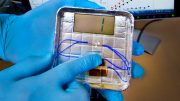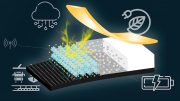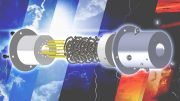The future could hold portable and wearable sensors for detecting viruses and bacteria in the surrounding environment. But we’re not there yet. Scientists at Tohoku University have been studying materials that can change mechanical into electrical or magnetic energy, and vice versa, for decades. Together with colleagues, they published a review in the journal Advanced Materials about the most recent endeavors into using these materials to fabricate functional biosensors.
“Research on improving the performance of virus sensors has not progressed much in recent years,” says Tohoku University materials engineer Fumio Narita. “Our review aims to help young researchers and graduate students understand the latest progress to guide their future work for improving virus sensor sensitivity.”
Piezoelectric materials convert mechanical into electrical energy. Antibodies that interact with a specific virus can be placed on an electrode incorporated onto a piezoelectric material. When the target virus interacts with the antibodies, it causes an increase in mass that decreases the frequency of the electric current moving through the material, signaling its presence. This type of sensor is being investigated for detecting several viruses, including the cervical-cancer-causing human papilloma virus, HIV, influenza A, Ebola and hepatitis B.
Magnetostrictive materials convert mechanical into magnetic energy and vice versa. These have been investigated for sensing bacterial infections, such as typhoid and swine fever, and for detecting anthrax spores. Probing antibodies are fixed onto a biosensor chip placed on the magnetostrictive material and then a magnetic field is applied. If the targeted antigen interacts with the antibodies, it adds mass to the material, leading to a magnetic flux change that can be detected using a sensing ‘pick-up coil’.
Narita says that developments in artificial intelligence and simulation studies can help find even more sensitive piezoelectric and magnetostrictive materials for detecting viruses and other pathogens. Future materials could be coilless, wireless, and soft, making it possible to incorporate them into fabrics and buildings.
Scientists are even investigating how to use these and similar materials to detect SARS-CoV-2, the virus that causes COVID-19, in the air. This sort of sensor could be incorporated into underground transportation ventilation systems, for example, in order to monitor virus spread in real time. Wearable sensors could also direct people away from a virus-containing environment.
“Scientists still need to develop more effective and reliable sensors for virus detection, with higher sensitivity and accuracy, smaller size and weight, and better affordability, before they can be used in home applications or smart clothing,” says Narita. “This sort of virus sensor will become a reality with further developments in materials science and technological progress in artificial intelligence, machine learning, and data analytics.”
Reference: “A Review of Piezoelectric and Magnetostrictive Biosensor Materials for Detection of COVID‐19 and Other Viruses” by Fumio Narita, Zhenjin Wang, Hiroki Kurita, Zhen Li, Yu Shi, Yu Jia and Constantinos Soutis, 24 November 2020, Advanced Materials.
DOI: 10.1002/adma.202005448










Be the first to comment on "Grabbing Viruses Out of Thin Air: Portable Sensors for Detecting COVID-19 and Other Viruses"